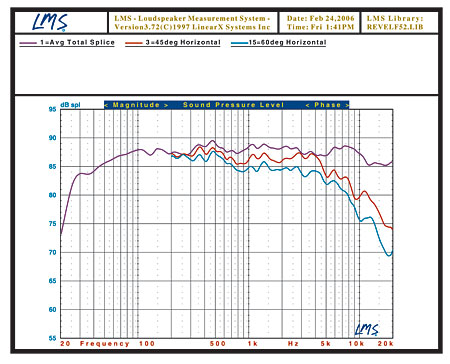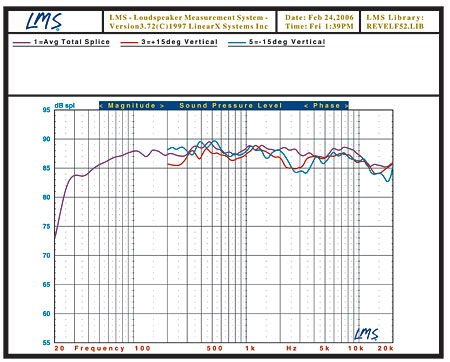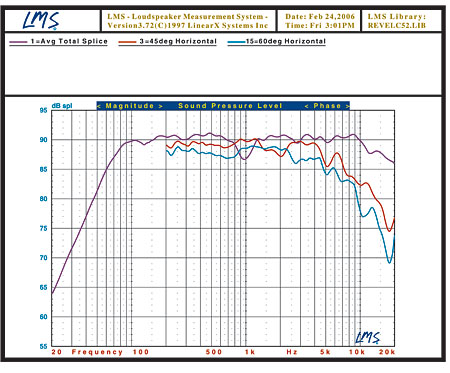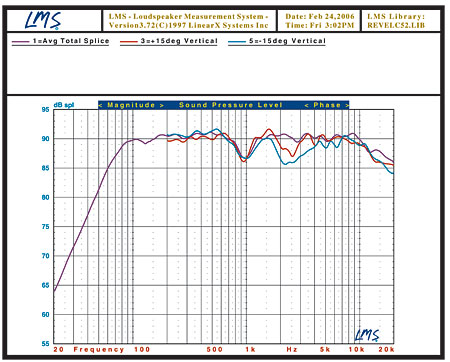Revel Performa F52 Speaker System Measurements
For logistics reasons, the samples measured were different than the ones auditioned. All measurements shown here for the F52 and C52 were made with the grilles removed. The grille actually made little measured difference in the response of either speaker, though in both speakers it was slightly smoother with the grilles off.
The impedance of the F52 dropped to a minimum of 4.1Ω at 2.2kHz. The impedance magnitude in the bass is more linear than we usually see, making it more difficult to judge the cabinet tuning, but it appears to be around 28Hz (dipping to 4.6Ω at this frequency). I would rate the speaker's nominal impedance conservatively at 5.5Ω. The impedance phase angle does become highly capacitive at very low frequencies, which may make the F52 relatively challenging to drive unless the very low frequencies are routed to a subwoofer. But I had no difficulty driving it full range with the amplifiers I used. The speaker's sensitivity measured approximately 88dB/2.83V/m.
The horizontal front response of the F52 is shown in Fig.1 (violet). This is the pseudo-anechoic response averaged over a 30° forward horizontal angle, taken at tweeter height, combined with the nearfield responses of the woofers and port.

Fig.1: Revel F52, pseudo-anechoic response off the horizontal axis at 45° (red) and 60° (blue).
The F52's averaged front horizontal response is very smooth and linear from 100Hz to 10kHz. There are some small ripples, but only a slight emphasis from 5kHz to 10kHz is likely to be audible, adding a little extra sparkle in the low treble. There is no evidence of excess warmth in the measured result. The bass response holds up strongly to very low frequencies, with an effective lower limit (-10dB) at 23Hz. That doesn't mean that you won't need a subwoofer, however. Those small 6.5" drivers go very low, but the demands of many film soundtracks (and some music as well) played back at high levels, require the sort of output and extension that only a larger, long excursion driver can supply.
Fig.2 shows the same averaged horizontal front response (violet), this time overlaid with the vertical responses taken at +15° (red) and –15° (blue). These curves suggest that your vertical ear position relative to the tweeter, within reason, will not be particularly critical with this speaker, but that if you sit above or below the tweeter axis you might experience a broad but shallow dip between 2kHz and 4kHz.

Fig.2: Revel F52, pseudo-anechoic response at 15° above (red) and 15° below (blue) the tweeter axis.
The Revel C52's impedance magnitude is so smooth that it is difficult to precisely judge the tuning frequency of its sealed cabinet. Its minimum impedance measured 3.44Ω at 351Hz. The impedance phase angle is benign in this case and I would rate the speaker's nominal impedance, very conservatively, at 4.5Ω. Its sensitivity measured approximately 90dB/2.83V/m. The C52 should be an easy load to drive as long as your amp or receiver is happy pushing a 4Ω load.
The measured front horizontal response of the C52, taken on the tweeter axis and averaged in the same manner as described above for the F52 (but no port here), is shown in Fig.3 (violet curve). The effective bass extension is approximately 46Hz (-10dB). The on-axis response is very smooth and flat; flatter in fact than the F52, apart from a narrow dip at 1kHz.

Fig.3: Revel C52, pseudo-anechoic response off the horizontal axis at 45° (red) and 60° (blue).
Fig.4 shows the vertical response of the C52 at + 15° (red) and –15° (blue), overlaid again with the averaged front horizontal response. The response at +15° is slightly better than at –15°.

Fig.4: Revel C52, pseudo-anechoic response at 15° above (red) and 15° below (blue) the tweeter axis.
The horizontal responses of both the F52 and the C52 show smooth, well-controlled rolloffs that increase at wider listening angles. But apart from this nearly universal speaker characteristic there are no other major aberrations. In particular, the off-axis response of the C52 shows no obvious signs of suckouts as you move progressively further off axis.
The low frequency boundary control (measured on the F52) produced a response change of approximately –2dB at and below 100Hz in the Contour position. In the Boundary position, the reduction increased to a maximum of –5dB at 20Hz. The tweeter level control (measured on the C52) increased the overall high frequency range by about +1dB in the +1dB position, but the –1dB position measured closer to –0.5dB.
Overall, there is much to praise and little to criticize in this excellent set of measurements turned in by both the Performa F52 and C52. Thomas J. Norton
All figures: Violet curve: pseudo-anechoic response on the tweeter axis, averaged across a 30° horizontal window, combined with nearfield responses of the woofers (and, in the F52, the port). All measurements were taken at 1 meter.





























































